Complete History of Egyptian Pyramids: From Djoser to the Last Pharaoh

The story of Egypt’s pyramids is one of evolution, ambition, and timeless ingenuity. As far as we know, Egypt’s first monumental structure was built for King Djoser around 2630 BC, not a true pyramid but a massive six-stepped mastaba that marked the beginning of monumental stone architecture. From that point on, royal tombs grew ever grander, and the art of pyramid building became the signature of ancient Egyptian kingship.
To date, archaeologists have identified roughly 130 to 140 pyramids scattered across Egypt, each revealing new insights into the nation’s ancient history. Curiously, the most impressive pyramids, the largest, most precise, and best preserved, are also the earliest.
Timeline of Pyramid History

2950 BC – The Era of Mastabas
At the dawn of the dynastic period, Egypt’s rulers were buried in rectangular, flat-roofed tombs with sloping sides known as mastabas. Made from mudbrick or stone, these tombs were the forerunners of the pyramids and reflected the growing complexity of royal burials.
2630 BC – Djoser’s Monument at Saqqara
At Saqqara, about 30 km south of modern Cairo, King Djoser of the Third Dynasty ordered the construction of a grand stone monument that transformed the mastaba tradition. Originally planned as a large single mastaba, it was expanded by stacking five additional layers on top, forming a six-stepped structure that rose to about 62 meters (205 feet).

This monument, often called the Step Pyramid, is better described as a six-stepped mastaba, symbolizing a giant staircase to the heavens. Beneath it lies a maze of tunnels stretching over 5.5 km (3.5 miles), leading to chambers and shafts that may have existed before the monument itself. It stands as the world’s first great stone monument and the foundation for all later pyramids.
2600 BC – Sneferu and the First True Pyramids
Sneferu, founder of the Fourth Dynasty, revolutionized pyramid construction. He began at Meidum, where he completed an earlier stepped monument similar in height to the later Pyramid of Menkaure at Giza.

At Dahshur, Sneferu’s architects refined their craft, creating the Bent Pyramid, which changes angle midway, and then the Red Pyramid, Egypt’s first true smooth-sided pyramid. The Red Pyramid remains the third largest in Egypt and represents the moment when engineering mastery met royal vision.
2589 BC – The Pyramids of Giza
During the reign of King Khufu, the Great Pyramid was erected on the Giza Plateau. Built between 2589 and 2504 BC, it originally stood about 146 meters (480 feet) tall, making it the tallest structure on Earth for nearly 4,000 years. Inside are the King’s Chamber, Queen’s Chamber, the Grand Gallery, and recently discovered hidden spaces, including a mysterious “Big Void.”

Khufu’s son, Khafre, built the second pyramid beside his father’s, along with the Great Sphinx that guards the plateau. His successor, Menkaure, constructed the third and smallest of the main Giza pyramids, completing the royal trio.
2360 BC – The Pyramid of Unas
In Saqqara, King Unas of the Fifth Dynasty added something new: inscriptions known as Pyramid Texts. These are the oldest religious writings ever discovered, carved into the walls of his burial chambers. They mark a shift from sheer architectural grandeur to spiritual and literary sophistication.
2050 BC – The Middle Kingdom Revival
After the decline of the Old Kingdom, pyramid building returned during the Middle Kingdom. Kings of the 12th Dynasty revived the ancient royal tradition but with new methods and smaller scale. Pharaohs such as Amenemhat I and Senusret I built pyramids at Lisht, while Amenemhat II, Senusret II, and Senusret III constructed theirs at Dahshur and El-Lahun.
These Middle Kingdom pyramids used a core of mudbrick covered with limestone casing, which made them more vulnerable to erosion and decay. However, they show refined planning and reflect the spiritual rebirth of the pharaoh’s divine kingship.
The Pyramid of Senusret II at El-Lahun is particularly significant, as it marks a transition toward more complex funerary layouts and hidden entrances. The El-Lahun complex also demonstrates the architectural connection between the royal residence and the pyramid itself.
1500 BC – The Last Pyramid
By the time of King Ahmose I of the 18th Dynasty, pyramid building had largely faded. Ahmose built a modest pyramid at Abydos, the final royal pyramid ever constructed in Egypt. After his reign, pharaohs preferred rock-cut tombs in the Valley of the Kings, where secrecy replaced size as the priority.
Modern Times – Rediscoveries and Revelations
In 1954, archaeologists uncovered the Khufu Ship, an ancient cedar vessel buried beside the Great Pyramid, astonishingly well preserved. In 2013, papyri discovered at Wadi el-Jarf revealed detailed records of pyramid construction, including how limestone blocks were transported from Tura via canals under the supervision of Khufu’s half-brother, Ankhaf.
In 2017, advanced scanning technology detected a massive internal void within the Great Pyramid, the first major internal discovery in over a century.
Today, the pyramids of Egypt stand side by side with modern Cairo, their timeless silhouettes rising above the desert edge. Despite centuries of research, these monuments still hold countless mysteries, continuing to inspire awe and wonder as the eternal legacy of ancient Egypt.

Comments